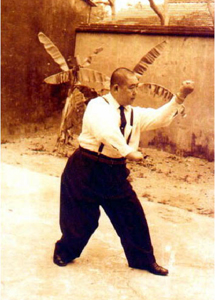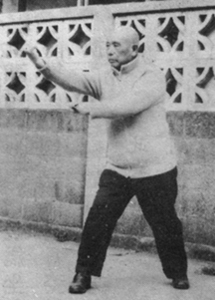|
|
|
Internal Mantis
by John Chang
When thinking about internal Kung Fu, the styles
that usually come to mind are Tai Chi, Bagua, and Hsing-Yi.
Traditionally, most styles of Praying Mantis are classified
as “external” and “hard” styles.
Traditional 8 Step Praying Mantis was deliberately created
to bring internal principles into a Praying Mantis style.
Born out of a marriage between Plum Blossom Praying Mantis,
Bagua, Hsing-Yi, and Tong-Bei, 8 Step Praying Mantis today
represents a truly internal Praying Mantis style that preserves
many Praying Mantis applications and techniques while focusing
largely on internal principles and power.
In the nineteenth century, Chiang Hua Long,
master of Plum Blossom Praying Mantis, spent most of his
life studying this powerful style. Toward the end of his
life, Chiang Hua Long became fascinated with the internal
principles of Bagua, Hsing-Yi, and Tong-Bei, learning extensively
from his contemporaries, Wang Zhong Qing, master of Bagua,
and Chen De Shan, master of Hsing-Yi and Tong-Bei. Together,
these three masters created 8 Step Praying Mantis in the
early twentieth century. Five years after the creation of
8 Step, at the age of 16, the young Wei Hsaio Tang began
studying 8 Step Praying Mantis under Feng Huan-Yi, the top
8 Step student who studied under Chiang Hua Long. Today,
students of traditional 8 Step Praying Mantis all trace
their lineage through Grandmaster Wei Hsaio Tang.
When I studied 8 Step Praying Mantis under
Grandmaster Wei, he exhibited extraordinary skill in the
internal martial arts. I can recall Grandmaster Wei asking
his most senior students to block his punch. He would throw
a very slow and relaxed punch toward them. One of the senior
students could block the punch only every once in a while
while the other student never blocked it successfully. The
punch would move so slowly that the students had ample time
to try several blocks before Grandmaster Wei’s fist
would finally reach its target. Still, they could not move
his arm with their blocks. Muscle had very little to do
with Grandmaster Wei’s power, as Grandmaster Wei was
in his seventies and his students were in their twenties.
Even today, I am unaware of anyone within the
8 Step community who has reached Grandmaster Wei’s
level of skill in the internal martial arts. Shifu Vincent
Chen, arguably one of the most knowledgeable leaders in
the 8 Step Praying Mantis community today, readily admits
that he is still aspiring to equal Grandmaster Wei’s
abilities.
The emphasis on internal arts makes 8 Step
Praying Mantis visibly distinct from other styles of Praying
Mantis. Practitioners of other Praying Mantis styles will
immediately notice a number of differences when watching
an 8 Step form. For example, the tell-tale mantis hand is
used much less frequently. The mantis hand itself is very
relaxed with tension only in the smallest finger and ring
finger, the two fingers used for gripping. Stances in 8
Step are often higher than in other Praying Mantis styles.
Bagua stylists will also clearly recognize some of their
own steps in some 8 Step forms.
 
Photos: Wang Shujin, Master of Bagua
and Hsing-Yi, followed by Grandmaster Wei demonstrating
the Tiger Set stance in 8-Step Praying Mantis, 8-Step's
primary "fighting stance."
Another noticeable difference in 8 Step forms
is speed—or the lack thereof. Practitioners of other
Praying Mantis styles may be surprised to see how slowly
8 Step students often practice their forms. Although speed
is clearly a virtue in any martial art, students of 8 Step
practice slowly to make sure they are precisely executing
the numerous subtleties of each technique. As they perfect
the subtleties of each move at slow speeds, they become
increasingly able to speed up without losing precision.
Eventually, students perform 8 Step forms a little more
slowly than most external styles, with sudden increases
in speed at the moments when a technique in the form should
release power. These sudden increases in speed allow the
student to feel whether or not the technique generated internal
power. Without much practice at slower speeds, the student’s
techniques would never generate significant internal power.
Monkey footwork in 8 Step is less noticeable
than in other Praying Mantis styles. Although 8 Step has
less leaping than other Praying Mantis styles, 8 Step still
retains the original spirit of monkey footwork for mobility,
controlling distance, changing the angle of attack, and
ground fighting.
Another byproduct of 8 Step’s focus on
internal arts is the limited number of techniques. To apply
internal principles and derive internal power from each
technique, 8 Step students must precisely practice each
technique with great attention to detail. My own beginning
students often spend months simply learning the straight
punch and a few stances, because of the numerous subtle
movements that must be brought together to produce internal
power. The attention to detail given to each technique makes
it impractical to learn a large number of techniques. More
external Praying Mantis styles offer a much greater variety
of techniques than 8 Step.
Those of us who practice 8 Step find it very
difficult to perform the forms of other Praying Mantis styles.
Aside from the immediately visible differences from external
Praying Mantis styles, 8 Step includes many subtle movements
and internal principles that create fundamental differences
in basic movements that might otherwise appear similar on
the outside. For example, internal power is derived more
from jing than muscular strength, which requires a precise
alignment of bones and joints. Mastering this precise alignment
explains, at least in part, how Grandmaster Wei in his 70’s
was able to prevent students in their 20’s from blocking
his slowly extended punch. All styles of Praying Mantis
use jing to varying degrees, but many reserve jing only
for the most advanced students. Students of 8 Step must
work on jing from a very early stage, or they risk never
truly understanding the fundamentals of the style. An 8
Step student who has learned to practice forms slowly, derive
power from jing, and pay great attention to each detailed
movement, will find it difficult to shift to a more external
Praying Mantis style that emphasizes muscular strength,
conditioning, speed, and a wider variety of techniques.
I believe that 8 Step Praying Mantis
enriches the larger world of Praying Mantis Kung Fu by extending
that world to include a truly formidable internal style
worthy of mention alongside better-known internal styles
such as Tai Chi, Bagua, and Hsing-Yi. Many styles of Praying
Mantis have already gained noteworthy recognition among
external Kung Fu stylists of all kinds. My hope is that
8 Step Praying Mantis will grow and one day win the same
recognition among internal Kung Fu stylists as well, helping
to further elevate the entire Praying Mantis family.
|
